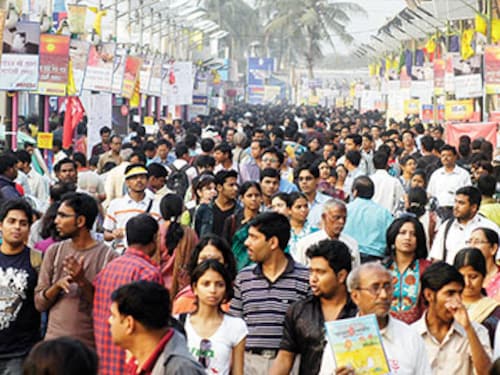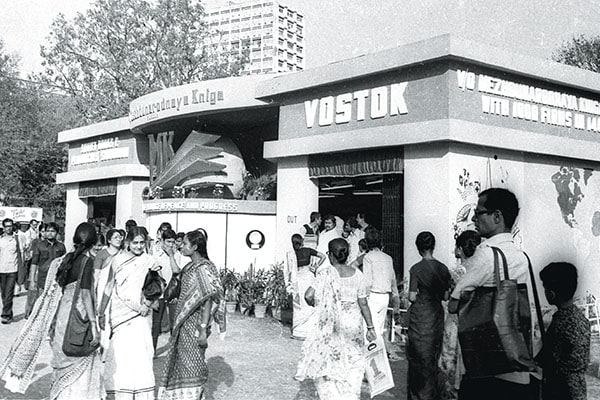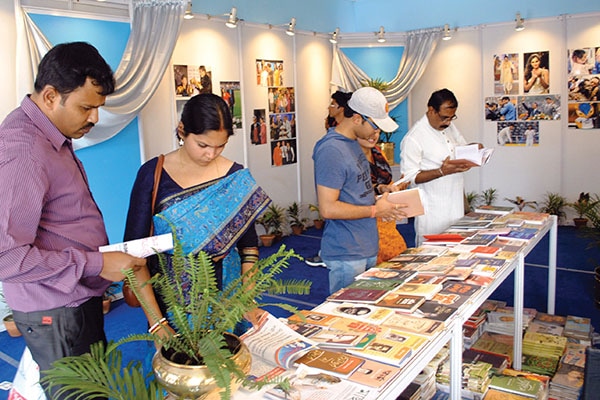Kolkata Book Fair: The city's love affair with literature
Kolkata's love affair with literature is intense. And the city's signature book fair is a symbol of that relationship


Sadly enough, the most abiding memory is of the dust. And it’s not just me. Actor, photographer and honorary Kolkatan Ashish Vidyarthi, asked for his first impressions of the Kolkata Book Fair, responded: “Dust!” Books, crowds, queues, books, food, odours, PA speakers, heat, music, fish… but unto dust thou shalt return. Books may be centrestage at the Kolkata Book Fair, but the dust is more than background noise. Keep an eye on it: It comes back with a vengeance in Act IV.
Book Fair. Boi Mela. Or in the more orotund Bengali of the apparatchiks: Grontho Mela. Forget, for a moment, about the numbers (we’ll look at those later too) try to ignore the Bengali emo-hype about its being part of the culture (or kaalchaar).
The Kolkata Book Fair (KBF) is a phenomenon. Large. Crowded. Noisy. Intellectual. (Oh, very intellectual!) Musical. Gastronomic. Artistic. Controversial. Chaotic. Resilient. In its own way, it encapsulates the character of its city and its most visible tribe: The literary Bengali. Each year since 1976—bar one—it takes over the city for 12 days. Well, usually 12 days. The year it rained, it ran for 15. After the fire in 1997, it put itself back together in three, and ran for a total of 20 days. Did I mention “resilient”?
Sure, the Frankfurt Book Fair displays more books, and arguably wheels more deals than any other. London has one too, and there’s BookExpo America, and so many others. But these are regulated. Staid. Predictable. And very different from the Kolkata Book Fair in one major aspect. These are trade fairs, meant for negotiations and transactions among those who run the commerce of reading. KBF is for the reader, the retail buyer, for those who revel in the proximity of books.  Readers in front of Vostok’s pavilion at Maidan, 1983. (Vostok is the publisher of the Bengali editions of popular Russian books)
Readers in front of Vostok’s pavilion at Maidan, 1983. (Vostok is the publisher of the Bengali editions of popular Russian books)
When the young Turks of the Kolkata publishing fraternity mooted the idea in 1975, the reactions of the grey eminences were typically Bengali: “Will you now sell books like handicrafts?! Or vegetables?!” It took great tact and finesse for the new Publishers and Booksellers’ Guild (established September 1975) to soothe their ruffled sensibilities. Quite surprisingly for the day and age, the first Kolkata Book Fair materialised within a year of ideation, with 34 publishers setting up 56 stalls in the heart of the city, on a patch of land between the Victoria Memorial and the Academy of Fine Arts.
That first year, the Book Fair started on March 9. Not the best season in Kolkata, with the mercury mounting and the threat of nor’westers. It was not till the fourth year of the Fair that the Guild resolved to hold it at the same time every year: Starting on the last Wednesday in January and running till the second Sunday of February, a total of 12 days, a schedule that has been maintained, as mentioned earlier, for the most part of 38 years.
Different generations have different memories of their first visit. Samrat Sengupta, corporate exec and quizzer, remembers that on his first visit in the 90s, he regarded the food stalls with the disapproval of the very young, and asked his parents “Why do these people come to eat at a book fair?” Satyaki Bhattacharya, green energy expert now exiled in Delhi, recalls the magic smell of new books, the sight of a little girl sitting on the grass furtively smelling her new comics the smell of lost childhood. For Sugato Guha, creative director and lyrcist who wrote the theme song for the Book Fair in the noughties, it was a second home: His father, Ramen Guha, was one of the founder organisers, and Sugato had the run of the fairground even while it was being set up. This was in the early 80s, when the Fair was still held outside Victoria Memorial.
I remember an even earlier phase, when the Fair was less crowded, more leisurely, before the huge queues outside the popular stalls (Ananda Publishers, Standard Literature, Vostok) and the all-pervasive smell of frying fish. My grandfather first took me to the Fair. I can no longer confirm the year from him, but I suspect that first visit was in its very first year. (By the time I entered college, it seemed the Book Fair had been held since the reign of Nebuchadnezzar.) I remember a child’s delight and wonder that there could be. So. Many. Books. All in one place! There was space, there was time to browse and to examine one’s newly-acquired hoard in the mellow winter sun.
But like Topsy, the Kolkata Book Fair just grow’d. And grow’d. By the late 80s, it was evident that the crowds were too large and the demand for stalls too high for the Fair to stay next to Victoria Memorial.
It moved to a corner of the Maidan, the huge green common that is Kolkata’s lung. The new site was even more central. It was at the corner of Park Street—then Kolkata’s most happening thoroughfare—and Outram Road, that ran through the Maidan. But it flattered to deceive. Tridib Chatterjee, in his brief monograph on the Book Fair, mentions how terrible the new site was the neglected corner was uneven, weed-grown and used as an ad hoc public convenience. It lay next to a large pond or young lake that, a hundred years before, had been known as the General Tank, but had become a mass of water-chestnut and other weeds, breeding mosquitoes, trapping garbage. But it offered 23 acres of space, convenient public transport and loads of parking. It took an effort to clean, level, and drain the scrubland, but it was well worth it.
The Maidan was and is an organic part of Kolkata’s winter. When the sun set through the haze on a January evening, the hubbub of the Fair would seem muted for a while. As dusk vanished and the lights came on, the hum would grow again to drown out the noise of traffic on Chowringhee and Park Street, until the bell rang at eight o’clock to signal the closing for the day. For the next 15 years, that corner was the home of the Book Fair.
Guha recalls how Satyajit Ray, giant both in form and in achievement, would come in early before the crowds massed, to stalk through the lanes between the stalls and browse with an unlit pipe hanging from the corner of his mouth. Trina Mukherjee, now a journalist in Mumbai, remembers the shiny toys and the soap bubbles from the hawkers at the gates, and of course the sonorous PA system with its lost-and-found announcements. By then, street theatre, poetry readings, an artists’ corner (christened Montmartre) and musical performances had become part of the menu. Buddhadeb Guha would regale audiences with his toppa singing and risqué jokes. Sunil Gangopadhyay and Shakti Chattopadhyay, enfants terrible even when they were acknowledged giants of the literary scene, would sip tea while reading poetry to a rapt audience. For a certain generation, Chattopadhyay’s voice, rough at the edges like his poetry, is part of their memories of the Fair. In the 90s and noughties, the harmoniums and Rabindra Sangeet shared the evening with guitars and folk rock. Image: Aranya Sen for Forbes India
Image: Aranya Sen for Forbes India
The crusty old gentlemen, who decried the commercialisation of books back in the 70s, would be red-faced now, if any are still extant. The Book Fair is, in its own way, a celebration of Mammon. It offers the bargains of the year. Anywhere in Kolkata, a common greeting during the Fair fortnight is “What did you find at the Fair this year?” Aanton Mukherjee, brand executive, smiles at the thought of children being dragged away morosely from their stall of choice by their parents because better bargains were available elsewhere. Guha still has two books of original artwork by Ralph McGuirre, bought for the princely sum of Rs 35 each. Mukherjee’s treasure is a beautifully illustrated book of Chinese fables, bought for a pittance and preserved for nearly three decades. From the munificence of grandparents through the penury of youth, my heist from the Book Fair each year was a gleeful victory over a malign universe even today the spoils lurk in the corners of my bookshelves.
The other common memory from the 70s and 80s is the Russian stalls. It would appear that the highest-selling author at the Fair then (after Rabindranath, of course!) was Arkady Gaidar with When Daddy was a Little Boy! The Vostok and 20th Century stalls, with their amazingly cheap offerings (including textbooks and books on science) are fondly remembered by every school and college student of the time. Of course we have all ended up buying books we didn’t like, but it was worth it for the heady feeling of getting on a bus with a bagful of books bought with a college student’s meagre resources.
And there are the ‘little magazines’. Every Bengali intellectual has a book inside him, sometimes two, and until they get around to winning the Booker or the Sahitya Akademi award, they publish their work themselves. One corner of the Fair would be reserved for these little magazines. Not without reason: Most of the giants of Bengali literature have contributed to them in their youth. And some of them may have prowled the lanes of the Book Fair with their shoulder bags, sometimes giving away copies of their magazines to promising readers. I confess I used to walk a little faster to escape their attentions, but age has brought tolerance.
Where there are books, there must be booklifters. In Kolkata, they were censured, but almost indulgently so. One offender caught in the act explained that he had a terminally ill brother whose only solace was reading. A touching story, except that the salesman knew him and pointed out that he was an only child. (He was let off after doing 20 squats for atonement.) Two guilty schoolgirls, sweating and red-faced, got a look over half-moon spectacles, a dressing-down from the stall-owner… and a gift of a book each!
The Maidan idyll, alas, didn’t last. Remember the dust? In 2006, a public interest litigation (PIL) challenged the Fair’s being held on the Maidan. The day before the 2007 edition, the Kolkata High Court ruled that the Fair caused environmental damage, including damage to the Victoria Memorial from the dust and fumes. At short notice, KBF was rescheduled and moved 16 kilometres away to the grounds of the Salt Lake Stadium.
Where it was promptly flooded out by unseasonal rain.
Again, the Fair pulled itself back together at short notice, and ran for 15 days instead of 12. But the organisers’ travails were not over.
In 2008, further PILs followed, and for the only time in 30-odd years, Kolkata went without its annual literary tryst. It was a huge gap in the cultural calendar.
The Fair was no longer only about books it celebrated music, art, theatre, all the things that make life pleasant. From the 80s, it has had a focus country each year (France, Great Britain, Spain, Australia, Cuba, Chile have all featured), and over the years, Richard Dawkins, Gunter Grass, Mulk Raj Anand, Paul Theroux and Alexander McCall Smith have been chief guests. (When Jacques Derrida was chief guest in 1997, the year of the fire, Annada Shankar Ray had quipped that he had taken deconstructionism too far.)
For the last three years, a literary festival has been held, first on the fringes and then, from last year, as part of the Fair itself. There is a children’s pavilion, there are seminars, book readings, plays a smorgasbord of literary delectation. And everywhere there is food, glorious Kolkata street food: Phuchkas, rolls, ‘Mughlai’ parathas, chaat, all the food we were taught to avoid and which we have longed for all our lives.
Since 2009, the venue has been the new Trade Fair Complex on the eastern edge of the city. Sales touched Rs 18 crore on the Maidan and have remained at that level at the new venue. But only 14 acres are available instead of the earlier 23, and the footfalls that are Kolkata’s pride have dropped from an all-time high of 2.5 million visitors over 12 days to about 1.8 million last year.
Sad, until one realises that the Frankfurt Book Fair, acclaimed as the world’s largest, has, ahem, 300,000! Frankfurt may be the largest in terms of commerce, but this fair in Kolkata is the world’s largest celebration of books.
Gunter Grass, an outspoken critic of Kolkata, said that the Book Fair is a metaphor of life: A beautiful creation that, like the city itself, will fade, while the books will endure.
First Published: Jan 15, 2015, 06:25
Subscribe Now